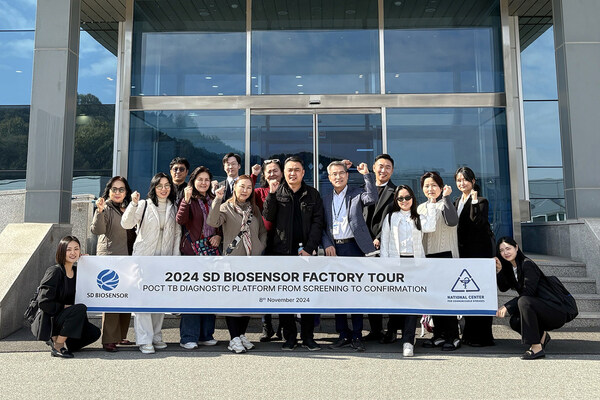- A team of officials from the National Center for Communicable Diseases, Mongolia (NCCD), had a tour around the Cheongju and Jeungpyeong Factories of SD Biosensor, a South Korea's global in-vitro diagnostics company, during their visit to Korea.
- SD Biosensor introduced total diagnostic platforms for liver cancer, cervical cancer, tuberculosis, respiratory diseases, etc.
SEOUL, South Korea, Nov. 20, 2024 /PRNewswire/ -- SD Biosensor, Inc. (KQ137310), South Korea's global in-vitro diagnostics company, stated that the National Center for Communicable Diseases, Mongolia (NCCD), visited SD Biosensor's Cheongju and Jeungpyeong Factories on November 8 and that the NCCD and SD Biosensor discussed cooperation measures to eradicate infectious diseases.

A commemorative photo of the NCCD’s visit to SD Biosensor’s Cheongju Factory / Photo provided by: SD Biosensor, Inc.
According to the World Health Organization (WHO), Mongolia is one of the countries with the highest incidence rates of liver cancer, cervical cancer, tuberculosis, etc. in the world. Among them, Mongolia's liver cancer incidence rate is the highest in the world, with Mongolian men's liver cancer incidence rate being 8 times as high as the global average and Mongolian women's liver cancer incidence rate being 16 times as high. Cervical cancer in Mongolia also has the highest incidence rate among Asian countries, and is the second most commonly detected cancer among Mongolian women, after liver cancer. However, Mongolia's cervical cancer screening rate is very low compared to its incidence rate, with only 29.7% of women in Mongolia aged 15 to 49 years ever having received cervical cancer screening. In addition, Mongolia is one of the top 30 countries selected by WHO in terms of the tuberculosis incidence rate. In particular, the tuberculosis infection rate among Mongolian adolescents is continuously increasing, with the childhood tuberculosis incidence rate of 10%.
This visit to Korea was intended to strengthen cooperation in responding to and eradicating infectious diseases. Nine officials from the National Center for Communicable Diseases, Mongolia (NCCD), visited and had a tour around SD Biosensor's Cheongju and Jeungpyeong Factories to see the various products that SD Biosensor produces. In particular, they had a look around the total diagnostic platforms that SD Biosensor produces for liver cancer, cervical cancer, tuberculosis, respiratory diseases, etc., and discussed early diagnosis solutions for these diseases.
Dr. Gantungalag Ganbaatar, Head of the Tuberculosis Surveillance and Research Department at NCCD, articulated her vision, stating, "We view this as a valuable opportunity to establish a partnership with SD Biosensor and explore potential collaboration in addressing and eliminating infectious diseases in Mongolia."
Derek Lee, Director of the Global Health Affairs Headquarters, SD Biosensor, expressed his aspirations by saying, "I hope that the NCCD's visit to Korea will serve as an opportunity for Korea and Mongolia to continue to strengthen their exchanges and cooperation in responding to and eradicating infectious diseases. SD Biosensor will continuously contribute to international health projects by creating various international cooperation models based on its infectious disease response know-how, diagnostic technologies and products."
SD Biosensor is an in-vitro diagnostics company that contributes to improving the quality of life by quickly and accurately diagnosing diseases under the slogan 'Beginning of all things that protect lives'. We have provided various diagnostic platforms to the IVD industry through the constant technological innovation such as POC Molecular Diagnostics, Fluorescent Immunoassay, Immunochromatography and BGMS. The headquarters of SD Biosensor is located in Korea and, the subsidiaries are placed in the USA, Brazil, Panama, India, Indonesia, China, Germany, Italy and Spain.
For relevant inquiries, please contact:
Manager Evie Baik, SD Biosensor, Inc. (E-mail: pr@sdbiosensor.com)
source: SD Biosensor
【你點睇?】民主派初選案,45名罪成被告判囚4年2個月至10年不等,你認為判刑是否具阻嚇作用?► 立即投票































